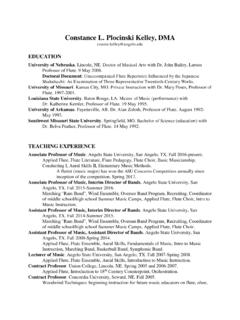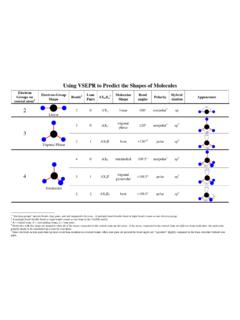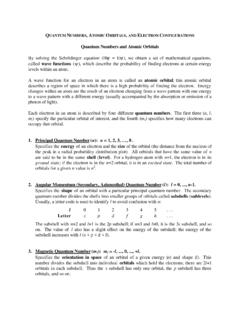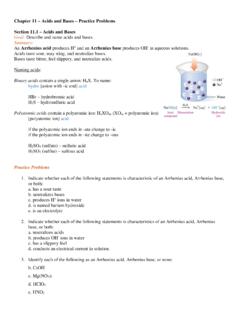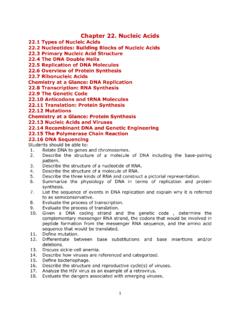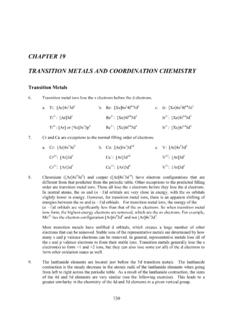Transcription of Ch 05 Carboxylic Acids and Esters - Angelo State University
1 chapter 5 Carboxylic Acids and EstersMr. Kevin A. BoudreauxAngelo State UniversityCHEM 2353 Fundamentals of Organic ChemistryOrganic and Biochemistry for Today (Seager & Slabaugh) Objectives: Learn to recognize the Carboxylic acid , ester, and related functional groups. Learn the IUPAC system for naming Carboxylic Acids and Esters . Learn the important physical properties of the Carboxylic Acids and Esters . Learn the major chemical reaction of Carboxylic Acids and Esters , and learn how to predict the products of ester synthesis and hydrolysis reactions. Learn some of the important properties of condensation polymers, especially the 5 Carboxylic Acids and Esters2 Carboxylic Acids Carboxylic Acids are weak organic Acids which contain the carboxyl group (RCO2H): The tart flavor of sour-tasting foods is often caused by the presence of Carboxylic Carboxylic acidOCOOHthe carboxyl groupCOHORCOOHRCO2 Hcondensed ways of writing the carboxyl groupChapter 5 Carboxylic Acids and Esters3 Nomenclature of Carboxylic Acids4 Nomenclature of Carboxylic Acids Select the longest carbon chain containing the carboxyl group.
2 The -eending of the parent alkane name is replaced by the suffix -oic acid . The carboxyl carbon is always numbered 1 but the number is not included in the name. Name the substituents attached to the chain in the usual way. Aromatic Carboxylic Acids ( , with a CO2H directly connected to a benzene ring) are named after the parent compound, benzoic acidChapter 5 Carboxylic Acids and Esters5 Examples: Naming Carboxylic Acids Name the following compounds:HCOHOCH3 COHOCH3CH2 COHOCCH2CH2CH3 HOO6 Examples: Naming Carboxylic Acids Name the following compounds:CH3 CHCH2 COHBrOCH3 CHCH2 COHCH2CH2CH3CH3 OCOHOCH3CH2 CHCH3 chapter 5 Carboxylic Acids and Esters7 Examples: Naming Carboxylic Acids Name the following compounds:CH3 CCH3 COHOCH2CH2 CHCH3CH3 CHCOHOCH38 Examples: Naming Carboxylic Acids Name the following compounds.
3 COHOCH3CH3CO2 HClCOOHCH3 CHCH3 chapter 5 Carboxylic Acids and Esters9 More Complicated Acids For molecules with two Carboxylic acid groups the carbon chain in between the two carboxyl groups (including the carboxyl carbons) is used as the longest chain; the suffix -dioic acidis used. For molecules with more than two Carboxylic acid groups, the carboxyl groups are named as Carboxylic acid acidCCH2 COHOOOH propanedioic acidCHCH2CH2 COCOCOOHOHHO propane-1,2,3-tricarboxylic acid10 Examples: Drawing Carboxylic Acids Draw structural formulas for the following molecules: 2-methylpropanoic acid 2,2,5-trimethylhexanoic acid 4,5-dimethyl-3-nitrooctanoic acidChapter 5 Carboxylic Acids and Esters11 Examples: Drawing Carboxylic Acids Draw structural formulas for the following molecules: para-bromobenzoic acid 2,4,6-trinitrobenzoic acid 4-ethylpentanedioic acid (what s wrong with this name?)
4 12 chapter 5 Carboxylic Acids and Esters13 Physical Properties of Carboxylic Acids14 Physical Properties of Carboxylic Acids Carboxylic Acids hydrogen bond to themselves to form a dimer:RCOOHRCOHORCOOHHOHOHH Carboxylic Acids also form hydrogen bonds towater molecules: chapter 5 Carboxylic Acids and Esters15 Physical Properties of Carboxylic Acids Since Carboxylic Acids can form more than one set of hydrogen bonds, their boiling points are usually higher than those of other molecules of the same molecular weight (MW). Low-MW Carboxylic Acids are generally liquids at room temp. (often, they are somewhat oily); higher-MW Carboxylic Acids are generally waxy solids. Carboxylic Acids with 12 to 20 carbon atoms are often referred to as fatty Acids , since they are found in the triglycerides in fats and oils (more later).
5 Short-chain Carboxylic Acids are also generally more soluble in water than compounds of similar MW, since they can hydrogen bond to more than one water Properties of Carboxylic Acids As the number of carbons in a Carboxylic acid series becomes greater, the boiling point increases and the solubility in water decreases. Many Carboxylic Acids that are liquids at room temperature have characteristically sharp or unpleasant odors. Ethanoic acid /acetic acid is the main ingredient in vinegar. Butanoic acid is partially responsible for the odor of locker rooms and unwashed socks. Hexanoic acid is responsible for the odor of Limburger cheese. Like most Acids , Carboxylic Acids tend to have a sour taste ( , vinegar, citric acid , etc.)
6 chapter 5 Carboxylic Acids and Esters17 Common NameStructural FormulaBP ( C)MP ( C)Solubility (g/100 mL H2O)Formic acidH CO2H101 8 InfiniteAcetic acidCH3 CO2H11817 InfinitePropionic acid CH3CH2 CO2H141 -21 InfiniteButyric acidCH3(CH2)2 CO2H164 -5 InfiniteValeric acidCH3(CH2)3 CO2H186 -345 Caproic acidCH3(CH2)4 CO2H205 -31 Caprylic acidCH3(CH2)6 CO2H239 17 InsolubleCapric acidCH3(CH2)8 CO2H270 32 InsolubleLauric acidCH3(CH2)10 CO2H 299 44 InsolubleMyristic acidCH3(CH2)12 CO2H Dec. 58 InsolublePalmitic acidCH3(CH2)14 CO2H Dec. 63 InsolubleStearic acidCH3(CH2)16 CO2H Dec. 71 InsolubleTable properties of some Carboxylic acids18 Boiling Points of Various Functional GroupsFigure boiling points of Carboxylic Acids compared to 1 alcohols, aldehydes and ketones, ethers and 5 Carboxylic Acids and Esters19 NameMolecular weightBoiling pointSolubility in waterPentane72 g/mol35 CInsolubleDiethyl ether74 g/mol35 CInsolubleButanal72 g/mol76 g / 100 mL H2O1-Butanol74 g/mol118 g / 100 mL H2 OPropanoic acid74 g/mol141 CInfiniteBoiling Point: Carboxylic acidAlcoholsAldehydes/KetonesEthersAlkan esWater Solubility: Carboxylic acidAlcoholsAldehydes/KetonesEthersAlkan esComparing Physical Properties20 Examples.
7 Predicting Physical Properties Arrange the following compounds in order of increasing boiling point. (All of the compounds have about the same molecular weight.) 1-pentanol hexane butanoic acid pentanal Which member of each of the following pairs of compounds would you expect to have a higher solubility in water? 2-butanone orpropanoic acid hexanoic acid orethanoic acidChapter 5 Carboxylic Acids and Esters21 Some Important Carboxylic Acids22 Important Carboxylic AcidsCOMethanoic acid (Formic acid )(from Latin formica, ant)A component of the venom of ants and caterpillars; produced in the body when methanol is consumedHOHCOE thanoic acid (Acetic acid )(from Latin acetum, vinegar)Vinegar is a 5% solution of acetic acid dissolved in water;acetic acid is also responsiblefor the taste of sour wine (fromthe oxidation of ethanol) and sourdough breadCH3 OHCOP ropanoic acid (Propionic acid )Found in Swiss cheese.
8 Salts of this acid are used as mold inhibitorsCH3CH2 OHCOB utanoic acid (Butyric acid )(from Latin butyrum, butter)This acid has a foul, rancid odor;produced from the breakdown ofsoft triglycerides in butterCH3CH2CH2 OHCOH exanoic acid (Caproic acid )Responsible for the odor of Limburger 5 Carboxylic Acids and Esters23para-Aminobenzoic aid (PABA)Used in sunscreens; absorbs short-wavelength UV light. It is also required by bacteria for the production of folic acid , needed to maintain the growth of healthy cell walls; sulfa drugs block the uptake of PABA by bacteria, causing them to be unable to manufacture folic acid , and thus preventing the bacteria from multiplyingOHOH2N2-hydroxy-1,2,3-propane tricarboxylic acid (Citric acid )Found in citrus fruits (lemons, grapefruit, oranges, etc.)
9 ; commonly used in buffering solutions with sodium citrateOHOHOHOOOHOO xalic acidFound in many leafy green plantssuch as rhubarb and spinach; combines with calcium ions in thebody to produce insoluble salts, which form kidney stonesHOOOHOT erephthalic acidA white, crystalline solid; used in the manufacture of some polyestersOHOHOO24 Glycolic acidAn alpha-hydroxy acid used in cosmetics and skin creams; alpha-hydroxy Acids are thought to loosen the cells of the epidermis and accelerate the flaking off of dead skin; however these compounds can increasethe skin's sensitivity to UV lightOOHHO2-hydroxypropanoic acid (Lactic acid )Produced from the fermentation of sugars under anaerobic conditions; found in sweat, sour milk, fermented pickles, sauerkraut, and yogurt; produced in muscles from glucose under anaerobic conditions (the buildup of lactic acid leads to a heavy, weak feeling, and muscle cramps); produced after death during the breakdown of sugars in the body by bacteria, inactivating the enzymes that allow the transport of calcium ions, causing rigor mortisOHOOHM alic acidResponsible for the sharp taste of apples (genus Malus)OHOOHHOOC hapter 5 Carboxylic Acids and Esters25 Tartaric acidFound naturally in wine, and is responsible for some of the sharp taste of wine; it is added to many sour-tasting sweet foods.
10 The potassium salt, cream of tartar, has many cooking applications; the potassium-sodium salt, Rochelle salt, acidOccurs naturally in many plants, and is essential for vegetable and animal tissue respiration; used in baking powders, and in some fruit drinks as a replacement for citric acidOOHHOOS uccinic acidAn intermediate along the citric acid cycleOOHHOONOHON iacinA water-soluble, B-Complex vitamin obtained from fish, green vegetables, lean meat, poultry,whole-grain and enriched bread and cereal; produced in the body from tryptophan; essential for growth, healthy tissues, the production of energy from carbohydrates, and the production of fats26 Monosodium Glutamate (MSG)The sodium salt of the amino acid glutamate; produced in meat during the decomposition of proteins; with inosine monophosphate (IMP), one of the major substances responsible for the flavor of meat; MSG is also added to some foods to enhance their meaty flavorHOO- Na+OONH2H2 NOHOG amma-aminobutanoic acid (GABA)A inhibitory neurotransmitter; ethanol binds to the same protein as GABA at a neighboring location, distorting the protein so that GABA binds more easily, further inhibiting thecell from firing; benzodiazepines such as Valium also bind tothe same protein but at a different site, inhibiting the cell still further, and sometimes with deadly consequencesPantothenic acidA water-soluble B-complex vitamin.




